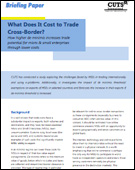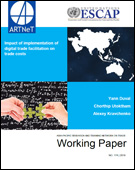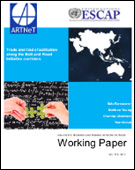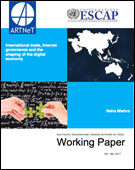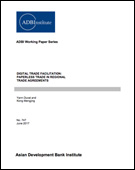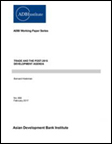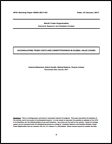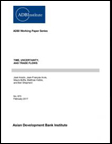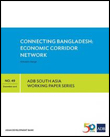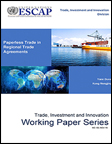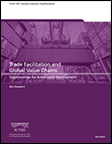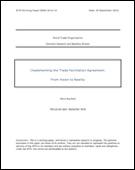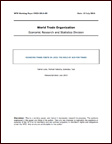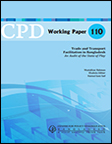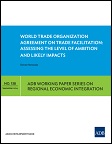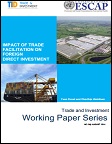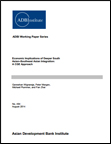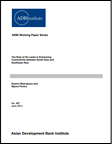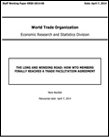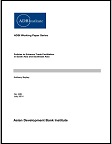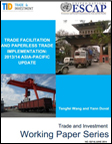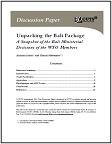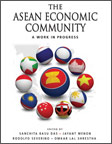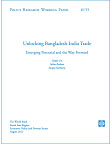Trade Facilitation Results
Trade facilitation focuses on removing barriers to the international movement of goods to lower trade costs, at and around the borders, and along the supply chain, to make countries more competitive in regional and global markets. In the SASEC subregion, bottlenecks in trade facilitation are the leading non-tariff barriers that constrain intraregional trade. SASEC initiatives in trade facilitation aims to make cross-border trade and transport in the subregion faster, cheaper, and more predictable, while maintaining the security of the supply chain and ensuring the effectiveness and efficiency of the institutions involved.
TRANSPORT REGIONAL & INTERNATIONAL
WORKING PAPERS
total items: 25Customs duties, local taxes, and customs clearance increase trade costs and serve as obstacles for many small and medium enterprises. This paper explores challenges these enterprises face in using e-platforms and trading internationally. It looks at de minimis exemptions (the minimum value of goods below which no duties are collected) in India and other economies and analyzes the impact of these exemptions on exports by micro and small enterprises.
Source: Sanjay Kumar Mangla
This paper studies of the effect of the implementation of World Trade Agreement Trade Facilitation Agreement (WTO TFA) measures on trade costs in the Asia-Pacific region. Its analysis shows that full implementation of measures is associated with 15% reduction in trade cost. The paper also projects a 26% decrease in trade costs, amounting to $600 billion annually, with the full implementation of WTO TFA measures together with digital trade facilitation measures. It also looks at the need to develop legal and technical frameworks to support cross-border paperless trade, including the legal recognition of trade data and documents between public and private organizations in different countries.
Source: Yann Duval, Chorthip Utoktham, and Alexey Kravchenko
This paper reviews the current state of trade and trade facilitation among the countries along the six corridors under the Belt Road Initiative (BRI), and looks at the potential impact of infrastructure development on trade. It explores at the Bangladesh-China-India-Myanmar (BCIM) corridor, and reviews trade growth, tariff rates, logistics performance index, ease of trading across borders, and other indicators in those countries.
Source: Bala Ramasamy, Matthew Yeung, Chorthip Utoktham, and Yann Duval
The connection between trade and internet governance presents complex policy challenges in today’s digital economy. This working paper highlights several observations and findings on the complex relationship between international trade and the internet. It recognizes the fact that the internet is not only driven by economic factors, but is a complex phenomenon shaped by political and social engagement, technical efficiency, and cultural and moral considerations. It sees the importance of synergizing international trade and the internet, and recommends that the World Trade Organization and other trade institutions develop mechanisms to consult internet governance institutions such as the Internet Engineering Task Force, World Web Wide Consortium, Internet Corporation for Assigned Names and Numbers, International Telecommunications Union, Internet Society, and the Internet Governance Forum.
Source: Neha Mishra
Most regional trade agreements now feature one or more measures for electronically exchanging trade-related information. These measures are becoming essential to maintaining trade competitiveness and enabling effective participation in cross-border e-commerce. This paper examines the extent to which measures enabling paperless trade are included in regional trade agreements (RTAs), such as the Association of Southeast Asian Nations-India Free Trade Agreement. India leads the region with the highest number of RTAs involving paperless trade measures. Asia-Pacific RTAs now increasingly cover specific areas of paperless trade such as electronic certificates of origin and sanitary and phytosanitary certificates.
Source: Yann Duval and Kong Mengjing
Trade and services are instrumental in achieving the Sustainable Development Goals. While openness to trade improves economic growth prospects, sound trade policy and efforts to reduce the costs of trade are necessary to bridge the link between trade growth and poverty reduction. For low income countries, there is still great scope to leverage trade for development, and pursue better access to a products and services to improve welfare, which can significantly contribute to economic development. In keeping with the post-2015 development agenda, this paper recommends sustained efforts by governments to reduce trade costs, support policy reforms to improve services trade, and focus on trade cost reduction and services trade facilitation.
Source: Bernard Hoekman
This paper examines the implications of trade costs, including applied tariffs, transportation and insurance costs, on competitiveness at industry, national and global levels, and identifies where trade facilitation investment would have the highest social returns from the perspective of global value chains (GVCs). With trade costs amplified along GVCs, profitability of individual business operations are affected by incurred transaction expenses. The authors conclude that direct benefits of trade facilitation will be higher for countries that are not yet well integrated into international trade, but key traders who are at the core of GVCs also stand to gain much.
Source: Antonia Diakantoni, Hubert Escaith, Michael Roberts and Thomas Verbeet
This paper assesses the impact of international transit time and time-related uncertainty on bilateral trade, including their impact on trade costs. It concludes that international transit time matters primarily for South-South trade, while uncertainty is more important for North-North trade. Both factors are confirmed to be statistically and economically significant determinants of bilateral trade, including global value chains, and strengthens the ground on the emerging policy emphasis to address the overall costs faced by supply chain operators, including costs linked to uncertainty.
Source: Jose Anson, Jean-Francois Arvis, Mauro Boffa, Matthias Helble, and Benjamin Shepherd
Economic corridors anchored on transport connectivity could significantly boost Bangladesh's economic growth. This paper presents a new set of corridors for Bangladesh – a nine-corridor comprehensive integrated multimodal economic corridor network that will enhance Bangladesh’s role as land bridge between South Asia and Southeast Asia, and between South Asia and northern Asia. These proposed corridors are designed to sustain robust economic growth over the long term by improving regional connectivity, transit, and integration, alongside trade facilitation measures.
Source: Mohuiddin Alamgir
This working paper provides a comprehensive list of paperless trade measures in regional trade agreements, which have become more extensive, covering increasingly specific areas including certificate of origins and sanitary and phytosanitary certificates. It also confirms that the number of paperless trade measures have doubled between 2005-2008 and 2013-2016 at the global level, with regional trade containing more provisions than those featured in the World Trade Organization's Trade Facilitation Agreement. It introduces the new United Nations Treaty and Framework Agreement on Cross-Border Paperless Trade in Asia and the Pacific, which aims to become a tool for harmonized implementation of paperless trade provisions.
Source: Yann Duval and Kong Mengjing
This paper analyzes the relationship between global value chains (GVCs) and trade facilitation, and its contribution to sustainable development outcomes on low-income and least developed countries (LICs and LDCs). A key insight of the paper concludes that it is not fundamentally GVCs that drive the sustainable development implications of improved trade facilitation, but the resulting extension and intensification of economic activity. It underlines the importance of putting in place domestic regulatory infrastructure that considers the appropriate economic, social, and environmental dimensions to ensure that GVCs remain consistent with the global commitment to sustainable development, while expanding economic opportunities of LICs and LDCs.
Source: Ben Shepherd
Low income to upper-middle income countries stand to gain a 14.6% to 16.5% reduction in trade costs upon implementation of the World Trade Organization's (WTO) Trade Facilitation Agreement (TFA). This publication looks at progression of the TFA – from conclusion of the talks at the 2013 Bali Ministerial Conference to preparations for the Agreement to take effect, as the valedictory moment of the TFA's entry into force nears. It highlights milestones, discusses the state of the ratification process, reviews implementation schedules, and examines work still to be done.
Source: Nora Neufeld
This report analyzes the role of Aid for Trade in reducing trade costs in least developed countries (LDCs), where trade costs are high and constitute a major impediment to the countries' participation in international trade. The most important sources of trade costs in LDCs are inadequate transport infrastructure, cumbersome border procedures, and compliance with non-tariff measures for merchandise exports. The study covers countries from around the world, including trade facilitation and trade restrictions in Nepal, Bhutan, India, and other Asian countries.
This publication provides a detailed picture of the status of specific measures for trade and transport facilitation in Bangladesh. It identifies measures already adopted, including strengthening of trade-related institutions, improvements in Customs processes and procedures, and reduction of non-trade barriers, highlighting areas for improvement and identifying existing gaps, to allow for proposals to meet these gaps. The audit undertaken aims to support policy-makers in Bangladesh in mobilizing the financial resources required to build a modern and efficient trade and transport facilitation system.
Source: Mustafizur Rahman, Khaleda Akhter and Naimul Gani Saif
This ADB Working Paper Series on Regional Economic Integration presents a preliminary assessment of the new World Trade Organization Agreement on Trade Facilitation (ATF), level of commitment of each Member, and impacts of the ATF. One of the first substantial deliverables of the Doha Development Agenda – the ATF – need not be ambitious but could include softening language where developing Members made full commitments. Furthermore, the ATF can be a useful guide for trade facilitation reform.
Source: Shintaro Hamanaka
This United Nations Economic and Social Commission for Asia and the Pacific Trade and Investment Working Paper attempts to quantify the potential impact of trade facilitation on foreign direct investment (FDI) flows. The study uses bilateral FDI data from 2006 onward from both developing and developed countries, including South-South FDI flows, wherein contiguity (common border between source and host country) and geographic distance are found to be much more important factors. In applying an augmented FDI model framework to determine the effect of comprehensive international trade costs, the results show that both non-tariff and tariff costs are important determinants of FDI inflows.
Source: Yann Duval and Chorthip Utoktham
High tariff and non-tariff barriers, and costly transport links and inefficient trade facilitation measures continue to hamper the growth of trade between South Asia and Southeast Asia. This paper explores whether potential gains from improved connectivity—via Myanmar as inter-regional bridge—justify a high level of investment. Using an advanced computable general equilibrium (CGE) model, reduction of inter-regional tariffs, decreasing of non-tariff barriers by 50%, and cutting down of trade costs between South Asia and Southeast Asia by 15% yields a prediction of 8.9% rise in welfare in South Asia and Southeast Asia, and an increase of 6.4% in gross domestic product by 2030.
Source: Ganeshan Wignaraja, Peter Morgan, Michael Plummer, and Fan Zhai
As Sri Lanka rebuilds at the end of a 30-year conflict, its progress in improving physical infrastructure—including the Colombo port expansion and other programs for new expressways and road connectivity—has been significant. Yet, the country has seen a sharp decline in its overall exports-to-gross domestic product ratio. How Sri Lanka can benefit from greater connectivity with its neighbors in South Asia and Southeast Asia is discussed in this paper. Trade policies geared towards enhancing regional integration efforts could boost Sri Lanka's economy. Additionally, to lessen the challenges of financing and sustaining implementation of planned infrastructure development efforts, Sri Lanka could also implement a more stringent institutional and regulatory environment encouraging more private sector participation.
The conclusion of the Agreement on Trade Facilitation at the Bali negotiations in December 2013 marked the end of a journey that lasted almost a decade. As the first multilateral trade agreement successfully negotiated by World Trade Organization (WTO) ministers, it broke new ground in the decentralized, bottom-up way the negotiations were structured; in the manner the capacities and resources of developing countries were addressed; and in how the Agreement has shifted the system’s focus beyond policy barriers toward process frictions. The negotiated outcome is likely to have an impact not just on Trade Facilitation, but on the WTO and the multilateral trading system as a whole.
Source: Nora Neufeld
This Asian Development Bank Institute publication identifies the state of play of trade facilitation and provides an overview of intra- and inter-regional trade in South and Southeast Asia. It highlights key challenges and bottlenecks to effective trade facilitation, ranging from the lack of expert human resources such as information technology specialists in small landlocked countries (Bhutan and Nepal), to the high border transaction costs and severe congestion faced at border crossing points, and the lack of effective dialogue on bilateral enhancement of trade facilitation. Regional initiatives such as the South Asia Subregional Economic Cooperation Program aim to address these challenges through customs modernization and harmonization, automation, and the use of international best practices in border procedures.
Source: Anthony Bayley
This paper reports survey findings on progress in implementing various trade facilitation and paperless trade measures made by 29 countries in Asia and the Pacific, including six SASEC member countries. Factors considered include pre-arrival clearance, post-clearance audit, National Single Window, and authorized operator programmes. The survey reveals that while countries have prioritized automation and paperless trade at the regional level, there is an urgent need for regional arrangements that will facilitate cross-border exchange of trade-related electronic documents and information to enable smoother trade facilitation.
Source: Tengfei Wang and Yann Duval
The Bali Package represents a key turning point for the World Trade Organization. Covering trade facilitation, agriculture, and trade issues for developing and least-developed countries, it is set to increase trade activity on a global scale and lower the cost of doing international trade. This paper acts as a precursor to its implementation by identifying challenges countries may face, giving a brief history of each pillar, exploring the next possible steps for each ministerial decision, and examining the likely effects of this decision/agreement on various other stakeholders, particularly on consumers.
This publication explores the barriers and impediments to the realization of an ASEAN Economic Community (AEC), and to what extent its self-imposed deadline of 2015 for achievement of an AEC is more of a milestone of progress than a firm target. It examines whether the AEC is achievable, the obstacles faced in achieving it, and the measures required to help it become a reality.
Source: Asian Development Bank
This paper reports the survey findings that rice value chains are transforming in Bangladesh and India.
Source: Thomas Reardon / Bart Minten / Kevin Z. Chen / Lourdes Adriano
This working paper breaks down the importance of trade cooperation between Bangladesh and India by taking a closer look at the impacts of Bangladesh's increased market access to India, and their improved border connectivity. Employing data from national government resources and multilateral development organizations including the International Monetary Fund, World Bank, and World Trade Organization, the study provides an estimate of the trade potential of Bangladesh and India, and calculates the implications on costs of trade facilitation, among others. It also discusses ongoing challenges in bilateral relations and provides recommendations that will enable larger gains for the two contiguous countries.

